Gas–Water–Sand Inflow Patterns and Completion Optimization in Hydrate Wells with Different Sand Control Completions
Abstract
1. Introduction
2. Methodology
3. Materials and Methods
3.1. Apparatus and Materials
3.2. Procedure and Methods
- (1)
- Put the screen into the simulated wellbore and pack the gravel into the annular between the screen and casing, connect the experimental device, and check the air tightness of the device.
- (2)
- Add the compound formation sand to the automatic sand filler, and fill the liquid storage tank with water.
- (3)
- Open the screw pump to pump water into the pipeline, and check the sealing of the device.
- (4)
- Set the target water and gas flow rate, adjust the VCSP, realize the mixing of gas, water, and sand through the gas–water mixer, turn on the screw pump, and return the pump to start the experiment.
- (5)
- Collect the flow and pressure data in real time through the data acquisition system to calculate the permeability of the screen and gravel packing layer, record the height of the gas–water interface in the wellbore annular by a camera, and collect and measure the volume of the sand deposited in the annulus at the end of the experiment.
4. Results
4.1. Inflow Pattern in SAS Completion
4.1.1. Situation of Vertical SAS Well
- (1)
- Gas–water interface
- (2)
- Influencing factors
4.1.2. Gas-Water–Sand Inflow in Horizontal SAS Well
4.1.3. Mechanism of Gas–Water Interface Transition
4.2. Inflow Pattern Analysis of GP Well
4.2.1. Uniform Inflow Pattern
4.2.2. Erosion Failure of Packed Gravel
4.2.3. Plugging Performance
4.3. Optimization of Completion
5. Discussion
6. Conclusions
- (1)
- The gas–water stratification occurs in horizontal and vertical wells with SAS completion. The gas is at the top of the wellbore, while the water carries sand at the bottom. The gas–water interface rises with the screen plugging. A high VCSP and low deviation angle exacerbated screen plugging, resulting in a faster rising rate of the gas–water interface. Moreover, the gas perturbation helps to unplug the screen when in a small GWR, but a high GWR increases the amount of sand suspended in the water, exacerbating the plugging degree of the screen. Therefore, the rising rate of the gas–water interface decreases first and then increases with the increase in the GWR. The screen is unevenly plugged due to the influence of the gas–water stratified flow, and the lower part of the screen is severely plugged, while the upper part maintains high permeability.
- (2)
- Gas–water–sand flow uniformly without the gas–water stratification phenomenon due to the complex pore-throat structure formed between the gravels in the horizontal and vertical wells with GP completion. However, the gravel rearranges and forms erosion holes under the impact of gas and water, and the erosion holes gradually expand, ultimately leading to the internal screen leakage of the gravel layer and the sand control failure of the GP completion. The stability of the gravel layer is significantly affected by the gravel packing degree and the GWR. The lower the gravel packing degree and the higher the GWR, the larger the erosion holes formed in the gravel layer.
- (3)
- For the SAS completion method, because the gas–water stratification flow causes uneven plugging of the screen, it is recommended to design the sand control accuracy of the screen in two sections. Increase the sand control accuracy of the lower part of the screen to enhance sand control performance. Conversely, decrease that of the upper part of the screen to maintain high permeability performance. For the GP completion method, the gravel layer is prone to instability, leading to sand control failure. Increase the gravel density under the premise of ensuring the stability of the hydrate reservoir to enhance the gravel packing degree, and use the coated ceramic with cementing effect to improve the stability of the gravel layer. In addition, when designing the sand control accuracy of the screen, it is not only necessary to consider the supporting gravel, but also, more importantly, it should be considered that the screen can directly control the formation sand.
Author Contributions
Funding
Institutional Review Board Statement
Informed Consent Statement
Data Availability Statement
Acknowledgments
Conflicts of Interest
References
- Sloan, E.D. Fundamental principles and applications of natural gas hydrates. Nature 2003, 426, 353–359. [Google Scholar] [CrossRef] [PubMed]
- Zhang, W.; Liang, J.; Wei, J.; Lu, J.; Su, P.; Lin, L.; Huang, W.; Guo, Y.; Deng, W.; Yang, X. Geological and geophysical features of and controls on occurrence and accumulation of gas hydrates in the first offshore gas-hydrate production test region in the Shenhu area, Northern South China Sea. Mar. Pet. Geol. 2020, 114, 104191. [Google Scholar] [CrossRef]
- Liu, L.; Sun, Z.; Zhang, L.; Wu, N.; Yichao, Q.; Jiang, Z.; Geng, W.; Cao, H.; Zhang, X.; Zhai, B. Progress in Global Gas Hydrate Development and Production as a New Energy Resource. Acta Geol. Sin. Engl. Ed. 2019, 93, 731–755. [Google Scholar] [CrossRef]
- Yang, M.; Zhao, J.; Zheng, J.; Song, Y. Hydrate reformation characteristics in natural gas hydrate dissociation process: A review. Appl. Energy 2019, 256, 113878. [Google Scholar] [CrossRef]
- Dong, C.; Gao, K.; Dong, S.; Shang, X.; Wu, Y.; Zhong, Y. A new integrated method for comprehensive performance of mechanical sand control screens testing and evaluation. J. Pet. Sci. Eng. 2017, 158, 775–783. [Google Scholar] [CrossRef]
- Dilimulati, S.; Dong, C.; Zhan, X.; Li, J.; Cui, G.; Liu, Q.; Bai, H. Experimental Investigation of Solids Production Mechanisms in a Hydraulic Screen-Through Fracturing Well in a Loose Reservoir and Its Control. SPE J. 2024, 29, 1818–1831. [Google Scholar] [CrossRef]
- Li, Y.L.; Ning, F.L.; Xu, M.; Qi, M.H.; Sun, J.X.; Nouri, A.; Gao, D.L.; Wu, N.Y. Experimental study on solid particle migration and production behaviors during marine natural gas hydrate dissociation by depressurization. Pet. Sci. 2023, 20, 3610–3623. [Google Scholar] [CrossRef]
- Lu, J.S.; Li, D.L.; He, Y.; Shi, L.L.; Liang, D.Q.; Xiong, Y.M. Experimental Study of Sand Production during Depressurization Exploitation in Hydrate Silty-Clay Sediments. Energies 2019, 12, 4268. [Google Scholar] [CrossRef]
- Uchida, S.; Klar, A.; Yamamoto, K. Sand production model in gas hydrate-bearing sediments. Int. J. Rock Mech. Min. Sci. 2016, 86, 303–316. [Google Scholar] [CrossRef]
- Uchida, S.; Klar, A.; Yamamoto, K. Sand Production Modeling of the 2013 Nankai Offshore Gas Production Test. In Proceedings of the Energy Geotechnics, Kiel, Germany, 29–31 August 2016. [Google Scholar] [CrossRef]
- Li, J.F.; Ye, J.L.; Qin, X.W.; Qiu, H.J.; Wu, N.Y.; Lu, H.L.; Xie, W.W.; Lu, J.A.; Peng, F.; Xu, Z.Q. The first offshore natural gas hydrate production test in South China Sea. China Geol. 2018, 1, 5–16. [Google Scholar] [CrossRef]
- Wu, N.; Li, Y.; Chen, Q.; Liu, C.; Jin, Y.; Tan, M.; Dong, L.; Hu, G. Sand Production Management during Marine Natural Gas Hydrate Exploitation: Review and an Innovative Solution. Energy Fuels 2021, 35, 4617–4632. [Google Scholar] [CrossRef]
- Hunter, R.B.; Collett, T.S.; Boswell, R.; Anderson, B.J.; Digert, S.A.; Pospisil, G.; Baker, R.; Weeks, M. Mount Elbert Gas Hydrate Stratigraphic Test Well, Alaska North Slope: Overview of scientific and technical program. Mar. Pet. Geol. 2011, 28, 295–310. [Google Scholar] [CrossRef]
- Lei, H.; Yang, Z.; Xia, Y.; Yuan, Y. Prospects of gas production from the vertically heterogeneous hydrate reservoirs through depressurization in the Mallik site of Canada. Energy Rep. 2022, 8, 2273–2287. [Google Scholar] [CrossRef]
- Boswell, R.; Schoderbek, D.; Collett, T.S.; Ohtsuki, S.; White, M.; Anderson, B.J. The Iġnik Sikumi Field Experiment, Alaska North Slope: Design, Operations, and Implications for CO2–CH4 Exchange in Gas Hydrate Reservoirs. Energy Fuels 2017, 31, 140–153. [Google Scholar] [CrossRef]
- Yamamoto, K.; Terao, Y.; Fujii, T.; Ikawa, T.; Seki, M.; Matsuzawa, M.; Kanno, T. Operational overview of the first offshore production test of methane hydrates in the Eastern Nankai Trough. In Proceedings of the Offshore Technology Conference, Houston, TX, USA, 5–8 May 2014. [Google Scholar] [CrossRef]
- Liu, Z.; Wang, Z.; Sun, J.; Chen, L.; Wang, J.; Sun, B. Risk and preventive strategies of hydrate reformation in offshore gas hydrate production trials: A case study in the Eastern Nankai Trough. J. Nat. Gas Sci. Eng. 2022, 103, 104602. [Google Scholar] [CrossRef]
- Ye, J.L.; Qin, X.W.; Xie, W.W.; Lu, H.L.; Ma, B.J.; Qiu, H.J.; Liang, J.Q.; Lu, J.A.; Kuang, Z.G.; Lu, C. The second natural gas hydrate production test in the South China Sea. China Geol. 2020, 3, 197–209. [Google Scholar] [CrossRef]
- Feng, Y.; Chen, L.; Suzuki, A.; Kogawa, T.; Okajima, J.; Komiya, A.; Maruyama, S. Numerical analysis of gas production from reservoir-scale methane hydrate by depressurization with a horizontal well: The effect of permeability anisotropy. Mar. Pet. Geol. 2019, 102, 817–828. [Google Scholar] [CrossRef]
- Xu, Z.; Hu, T.; Pang, X.Q.; Wang, E.Z.; Liu, X.H.; Wu, Z.Y.; Chen, D.; Li, C.R.; Zhang, X.W.; Wang, T. Research progress and challenges of natural gas hydrate resource evaluation in the South China Sea. Pet. Sci. 2022, 19, 13–25. [Google Scholar] [CrossRef]
- Chen, X.; Lu, H.; Gu, L.; Shang, S.; Zhang, Y.; Huang, X.; Zhang, L. Preliminary evaluation of the economic potential of the technologies for gas hydrate exploitation. Energy 2022, 243, 123007. [Google Scholar] [CrossRef]
- Deng, F.; Wang, Y.; Li, X.; Li, G.; Wang, Y.; Huang, B. A model-based study of the evolution of gravel layer permeability under the synergistic blockage effect of sand particle transport and secondary hydrate formation. Appl. Energy 2024, 355, 122209. [Google Scholar] [CrossRef]
- Wang, Z.; Zhang, Y.; Peng, Z.; Shan, Z.; Sun, B.; Sun, J. Recent Advances in Methods of Gas Recovery from Hydrate-Bearing Sediments: A Review. Energy Fuels 2022, 36, 5550–5593. [Google Scholar] [CrossRef]
- Deng, F.; Huang, B.; Li, X.; Liu, J.; Li, G.; Xu, Y.; Yin, B. Review of Sand Control and Sand Production in a Gas Hydrate Reservoir. Energy Fuels 2022, 36, 11712–11723. [Google Scholar] [CrossRef]
- Miri, R.; Salimi, M.; Stewart, S.; Gonzalez, J.M.B.; Suárez, C.M.; Nouri, A. Sand control screen selection for cased dual-annulus gas offshore wells based on scaled laboratory tests. Can. J. Chem. Eng. 2024, 102, 1957–1969. [Google Scholar] [CrossRef]
- Wang, Y.; Long, F.Q.; Li, X.; Xu, Y.T.; Kou, X. Experimental Study of Sand Migration under Distinct Sand Control Methods during Gas Hydrate Decomposition by Depressurization. Energy Fuels 2023, 37, 12966–12979. [Google Scholar] [CrossRef]
- Uchida, S.; Seol, Y.; Yamamoto, K. Sand Migration Simulation during Gas Production from Gas Hydrate Reservoir at Kuparuk 7-11-12 site in the Prodhoe Bay Unit, Alaska. Energy Fuels 2022, 36, 7382–7390. [Google Scholar] [CrossRef]
- Dong, C.; Wang, L.; Zhou, Y.; Huang, F.; Song, Y.; Zhou, B.; Xu, H. Microcosmic retaining mechanism and behavior of screen media with highly argillaceous fine sand from natural gas hydrate reservoir. J. Nat. Gas Sci. Eng. 2020, 83, 103618. [Google Scholar] [CrossRef]
- Ding, J.P.; Cheng, Y.F.; Yan, C.L. Research on sand control effect and micro-plugging mechanism of sand control medium in the development of natural gas hydrate reservoir. J. Pet. Sci. Eng. 2022, 215, 110703. [Google Scholar] [CrossRef]
- Ma, C.; Feng, Y.; Deng, J.; Wang, W.; Li, S.; Chu, M.; Gui, Y. Experimental investigation of the plugging mechanisms of non-consolidated prepacked gravel screens. Int. J. Hydrog. Energy 2021, 46, 34638–34651. [Google Scholar] [CrossRef]
- Wang, Y.; Cheng, K.; Yang, Y.; Tao, Y.; Li, Y. Microscopic mechanical analysis of sand production using a new arbitrary resolved-unresolved CFD-DEM model. Int. J. Multiph. Flow 2022, 149, 103979. [Google Scholar] [CrossRef]
- Li, Y.L.; Wu, N.Y.; Ning, F.L.; Gao, D.L.; Hao, X.L.; Chen, Q.; Liu, C.L.; Sun, J.Y. Hydrate-induced clogging of sand-control screen and its implication on hydrate production operation. Energy 2020, 206, 118030. [Google Scholar] [CrossRef]
- Gillespie, G.; Deem, C.K.; Malbrel, C. Screen Selection for Sand Control Based on Laboratory Tests. In Proceedings of the SPE Asia Pacific Oil and Gas Conference and Exhibition, Brisbane, Australia, 16–18 October 2000. [Google Scholar] [CrossRef]
- Lee, J.; Ahn, T.; Lee, J.Y.; Kim, S.J. Laboratory Test to Evaluate the Performance of Sand Control Screens During Hydrate Dissociation Process by Depressurization. In Proceedings of the Tenth ISOPE Ocean Mining and Gas Hydrates Symposium, Szczecin, Poland, 22–26 September 2013; Available online: https://onepetro.org/ISOPEOMS/proceedings/OMS13/All-OMS13/ISOPE-M-13-035/25372 (accessed on 20 August 2024).
- Ding, J.; Cheng, Y.; Yan, C.; Song, B.; Sun, H.; Teng, F. Experimental study of sand control in a natural gas hydrate reservoir in the South China sea. Int. J. Hydrog. Energy 2019, 44, 23639–23648. [Google Scholar] [CrossRef]
- Lu, J.S.; Xiong, Y.M.; Li, D.L.; Shen, X.D.; Wu, Q.; Liang, D.Q. Experimental Investigation of Characteristics of Sand Production in Wellbore during Hydrate Exploitation by the Depressurization Method. Energies 2018, 11, 1673. [Google Scholar] [CrossRef]
- Saucier, R.J. Considerations in Gravel Pack Design. J. Pet. Technol. 1974, 26, 205–212. [Google Scholar] [CrossRef]
- Li, Y.; Hu, G.; Liu, C.; Wu, N.; Chen, Q.; Liu, L.; Li, C. Gravel sizing method for sand control packing in hydrate production test wells. Pet. Explor. Dev. 2017, 44, 1016–1021. [Google Scholar] [CrossRef]
- Li, Y.L.; Wu, N.Y.; Gao, D.L.; Chen, Q.; Liu, C.L.; Yang, D.Y.; Jin, Y.R.; Ning, F.L.; Tan, M.J.; Hu, G.W. Optimization and analysis of gravel packing parameters in horizontal wells for natural gas hydrate production. Energy 2021, 219, 119585. [Google Scholar] [CrossRef]
- Dong, C.; Gao, K.; Xu, H.; Deng, J.; Hu, G.; Chen, Q. Experimental study on the influence of filling density on the sand blocking effect and stability of gravel. Oil Drill. Prod. Technol. 2018, 40, 123–130. [Google Scholar] [CrossRef]
- Najmi, K.; McLaury, B.S.; Shirazi, S.A.; Cremaschi, S. Experimental study of low concentration sand transport in wet gas flow regime in horizontal pipes. J. Nat. Gas Sci. Eng. 2015, 24, 80–88. [Google Scholar] [CrossRef]
- Chen, Y.; Sun, X.; Yan, T.; Yao, D.; Duan, R. Experimental study on micron-sized sand particles transport in the water flow path of hydrates production wellbore. J. Nat. Gas Sci. Eng. 2020, 73, 103088. [Google Scholar] [CrossRef]
- Wang, J.; Meng, Y.; Han, B.; Liu, Z.; Zhang, L.; Yao, H.; Wu, Z.; Chu, J.; Yang, L.; Zhao, J. Hydrate blockage in subsea oil/gas flowlines: Prediction, prevention, and remediation. Chem. Eng. J. 2023, 461, 142020. [Google Scholar] [CrossRef]
- Fajemidupe, O.T.; Aliyu, A.M.; Baba, Y.D.; Archibong, E.A.; Yeung, H. Sand minimum transport conditions in gas–solid–liquid three-phase stratified flow in a horizontal pipe at low particle concentrations. Chem. Eng. Res. Des. 2019, 143, 114–126. [Google Scholar] [CrossRef]
- Kamyab, M.; Rasouli, V. Experimental and numerical simulation of cuttings transportation in coiled tubing drilling. J. Nat. Gas Sci. Eng. 2016, 29, 284–302. [Google Scholar] [CrossRef]
- Wang, Z.Y.; Zhao, Y.; Zhang, J.B.; Pan, S.W.; Yu, J.; Sun, B.J. Flow assurance during deepwater gas well testing: Hydrate blockage prediction and prevention. J. Pet. Sci. Eng. 2018, 163, 211–216. [Google Scholar] [CrossRef]
- Ding, J.; Cheng, Y.; Yan, C.; Lu, C.; Li, Y.; Xue, M. Numerical simulation on sand production in the exploitation process of gas hydrates based on skeleton failure of reservoirs. J. Nat. Gas Sci. Eng. 2021, 94, 104052. [Google Scholar] [CrossRef]
- Dong, C.; Zhang, Q.; Gao, K.; Yang, K.; Feng, X.; Zhou, C. Screen sand retaining precision optimization experiment and a new empirical design model. Pet. Explor. Dev. 2016, 43, 1082–1088. [Google Scholar] [CrossRef]
- Pedroso, C.A.; Sanches, E.D.; Oliveira, N.S.; Fernandes, L.H.; Gomes, M.; Farias, R.; Mendez, A.; Frata, F.M. Lightweight Proppants: Solution for Gravel Packing Horizontal Wells under Extreme Conditions. In Proceedings of the SPE International Symposium and Exhibition on Formation Damage Control, Lafayette, LA, USA, 15–17 February 2006. [Google Scholar] [CrossRef]
- Pedroso, C.; Sanches, E.; Oliveira, N.; Fernandes, L.; Mickelburgh, I.J.; Coelho, G.S. New Solutions to Extend the Application Window of Horizontal Openhole Gravel Packing. In Proceedings of the SPE Annual Technical Conference and Exhibition, Dallas, TX, USA, 9–12 October 2005. [Google Scholar] [CrossRef]
- Abbaszadeh Shahri, A.; Shan, C.; Larsson, S.; Johansson, F. Normalizing Large Scale Sensor-Based MWD Data: An Automated Method toward A Unified Database. Sensors 2024, 24, 1209. [Google Scholar] [CrossRef] [PubMed]
- van Eldert, J.; Schunnesson, H.; Saiang, D.; Funehag, J. Improved filtering and normalizing of Measurement-While-Drilling (MWD) data in tunnel excavation. Tunn. Undergr. Space Technol. 2020, 103, 103467. [Google Scholar] [CrossRef]
- Ma, C.; Dou, Y.; Deng, J.; Hui, C.; Zhao, K.; Feng, Y.; Dou, L. Numerical simulations of sand-screen performance in unconsolidated prepacked gravel screen. Energy Sci. Eng. 2024, 12, 983–1003. [Google Scholar] [CrossRef]
- Farias, R.; Mendez, A.; Calderon, A. Best Practices and Lessons Learned in Open Brazil Hole Horizontal Gravel Packs Offshore. In Proceedings of the Offshore Technology Conference, Houston, TX, USA, 3–6 May 2004. [Google Scholar] [CrossRef]
- Chen, Z.; Novotny, R.J.; Farias, R.; Mendez, A.; Pedroso, C.A.; Fernandes, L.H.C. Gravel Packing Deep Water Long Horizontal Wells under Low Fracture Gradient. In Proceedings of the SPE Annual Technical Conference and Exhibition, Houston, TX, USA, 26–29 September 2004. [Google Scholar] [CrossRef]
- Bitencourt Zimmermann, J.H.; Haftani, M.; Wang, C.; Salimi, M.; Nouri, A. A novel laboratory technique for open-hole gravel-pack design. J. Pet. Sci. Eng. 2022, 215, 110713. [Google Scholar] [CrossRef]
- Taheri Shakib, J.; Ghaderi, A.; Abbaszadeh Shahri, A. Analysis of hydraulic fracturing length and aperture on the production rate in fractured reservoir. Life Sci. J. 2012, 9, 1769–1777. [Google Scholar] [CrossRef]



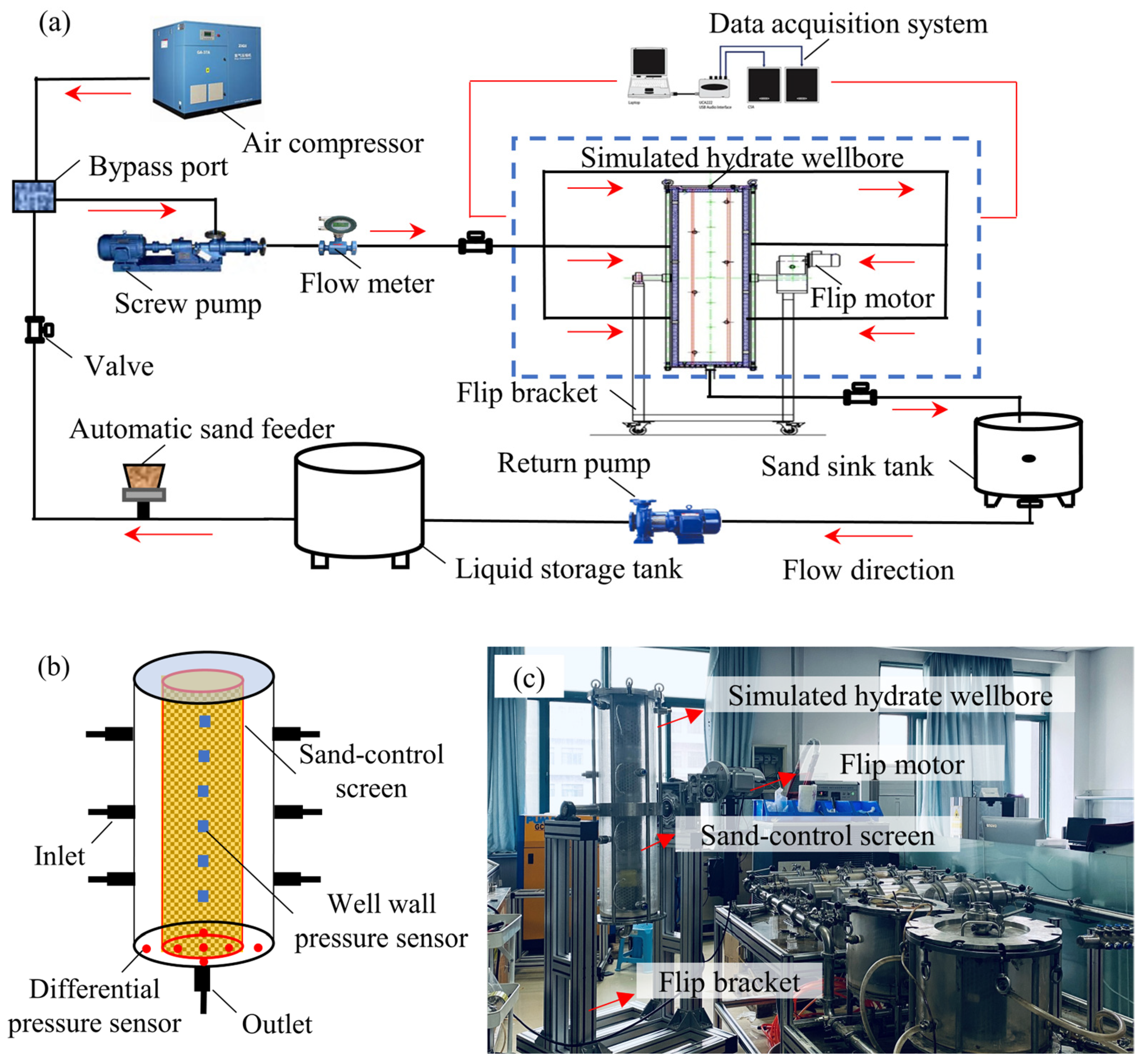

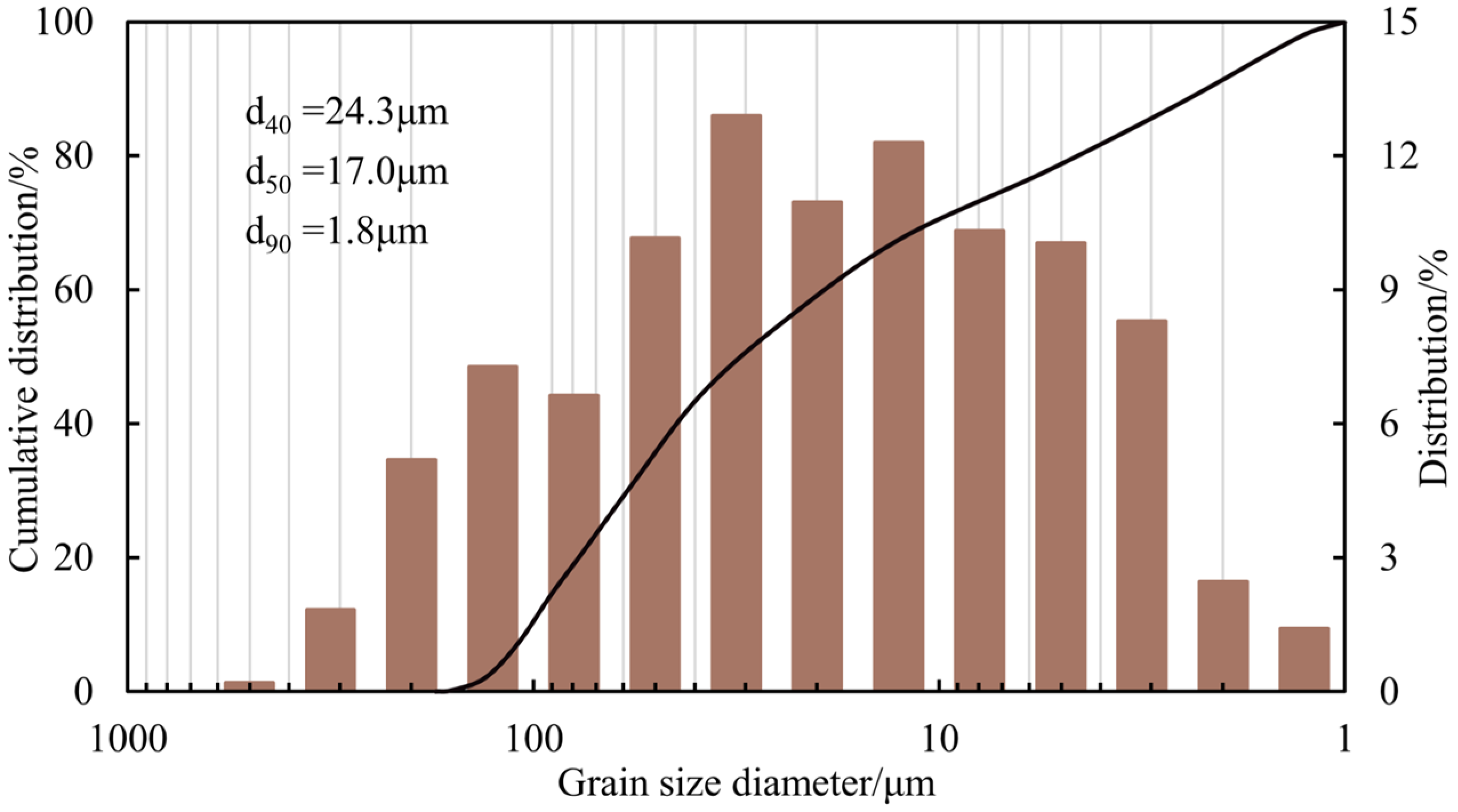
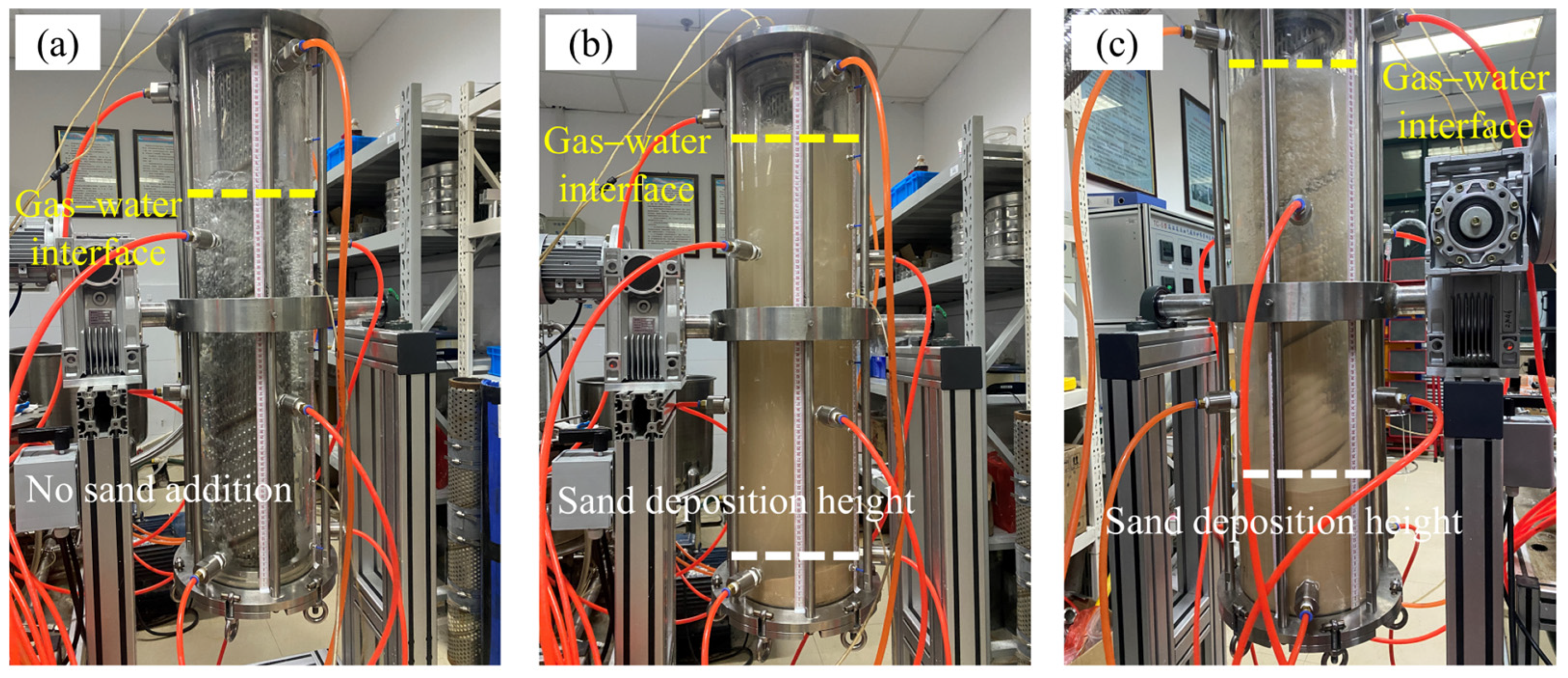
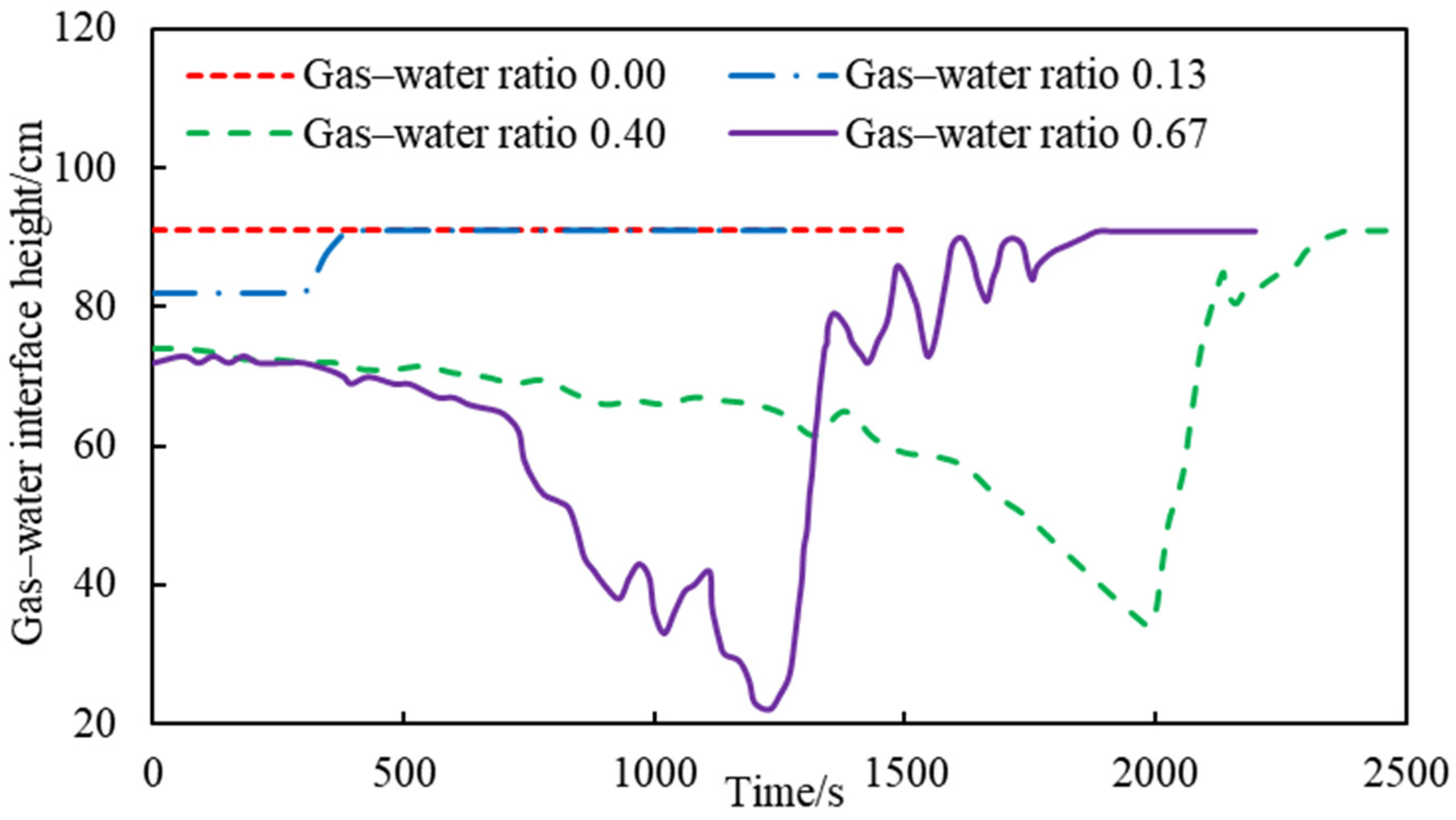
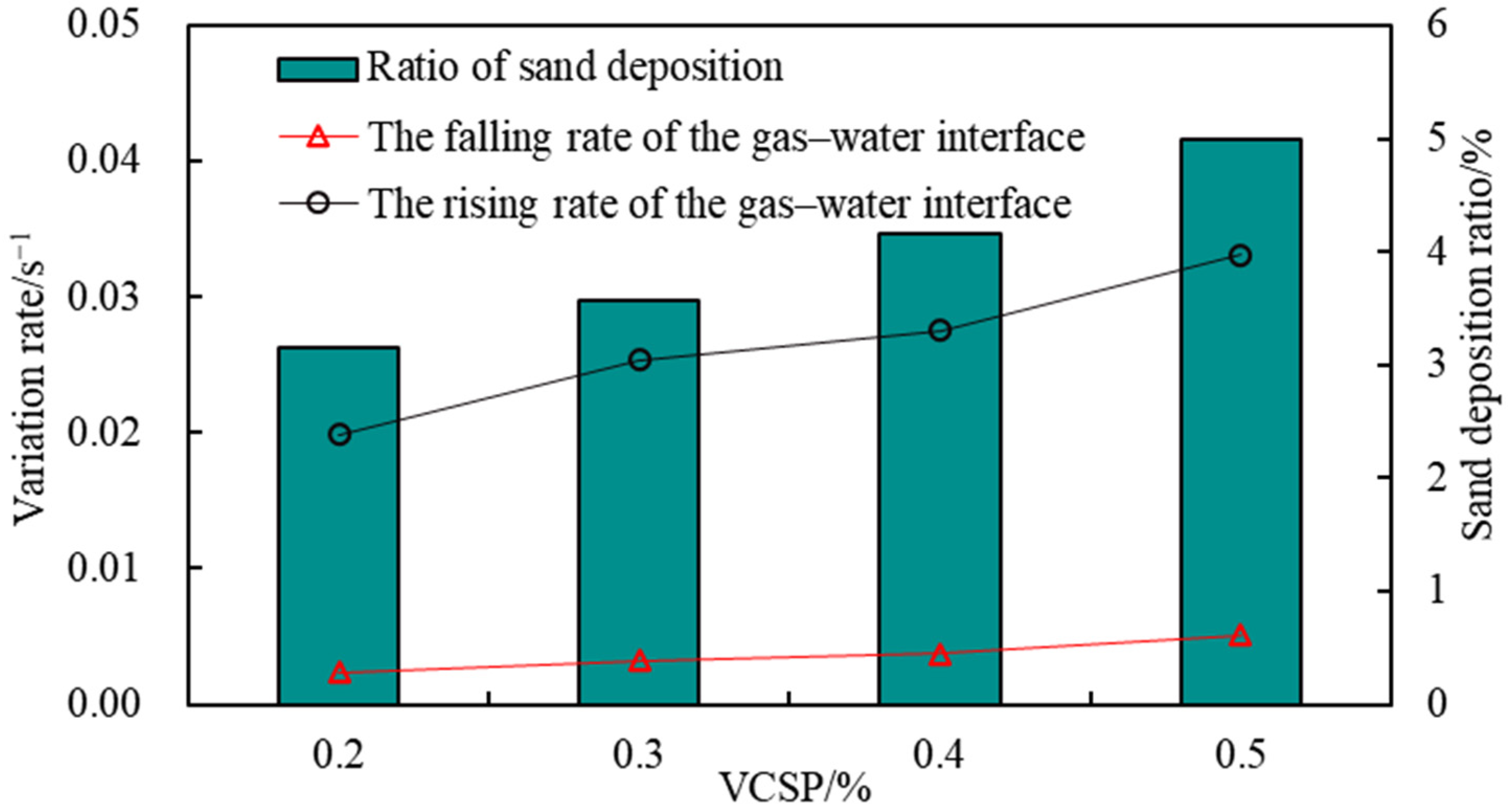
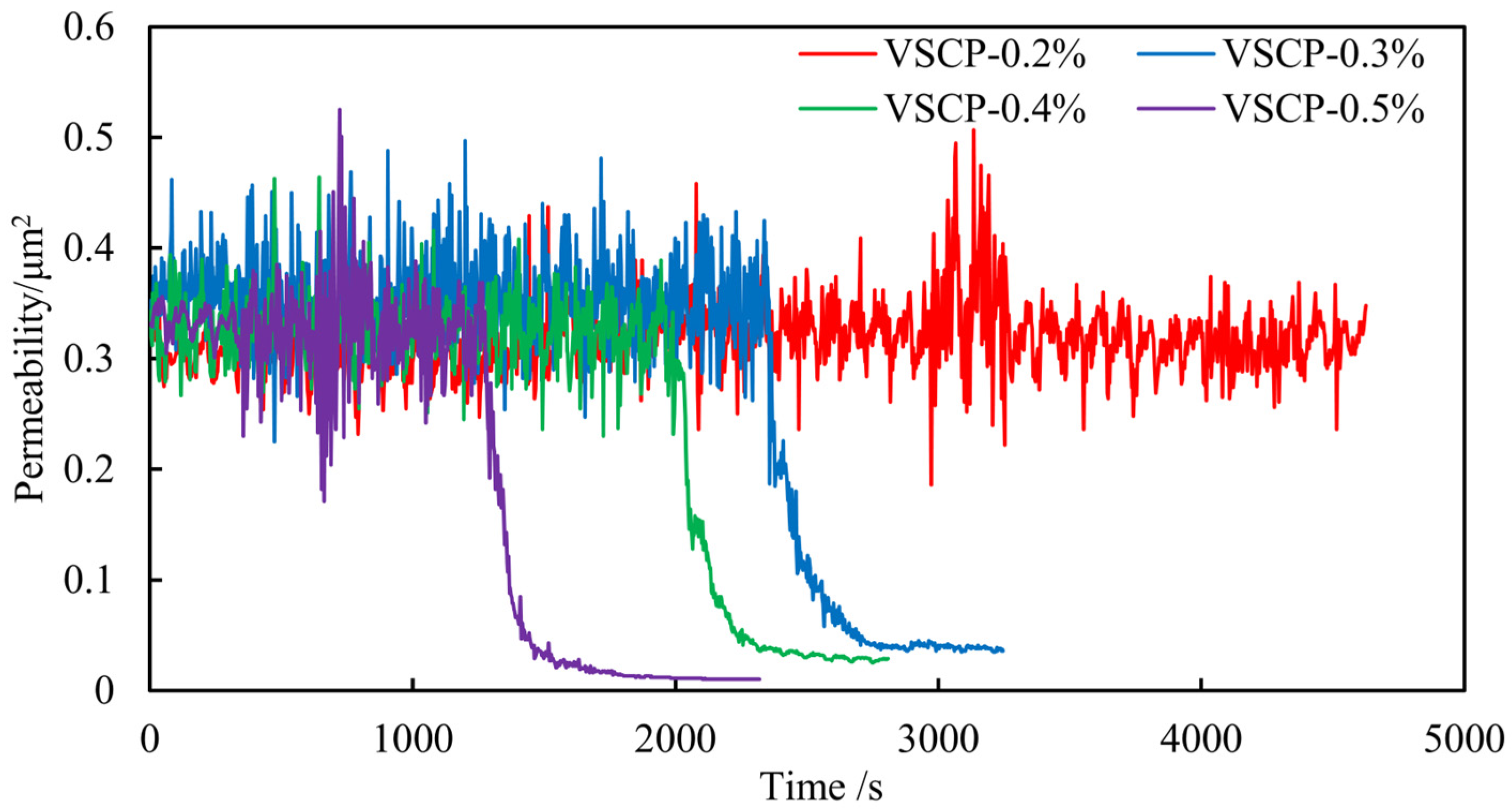
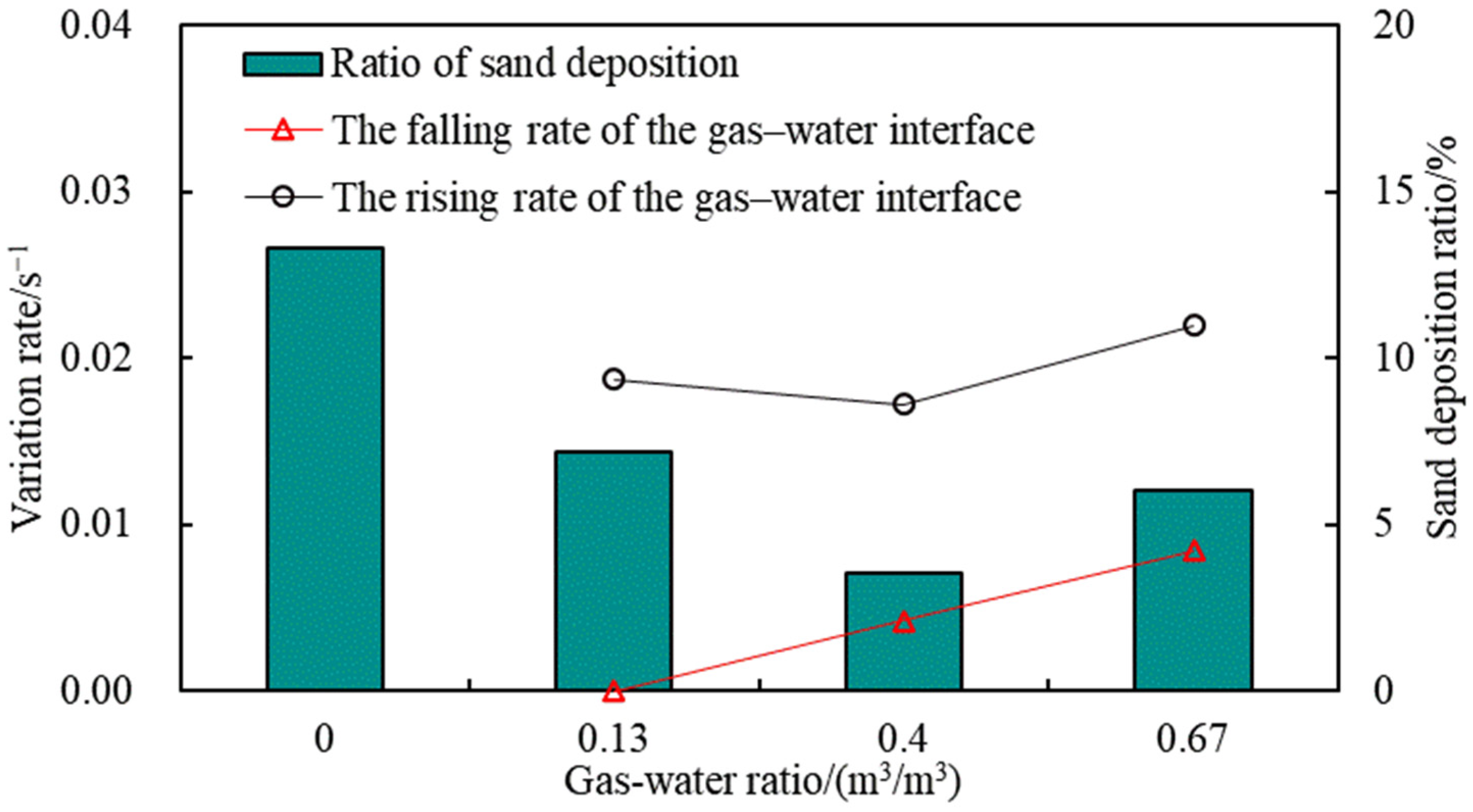
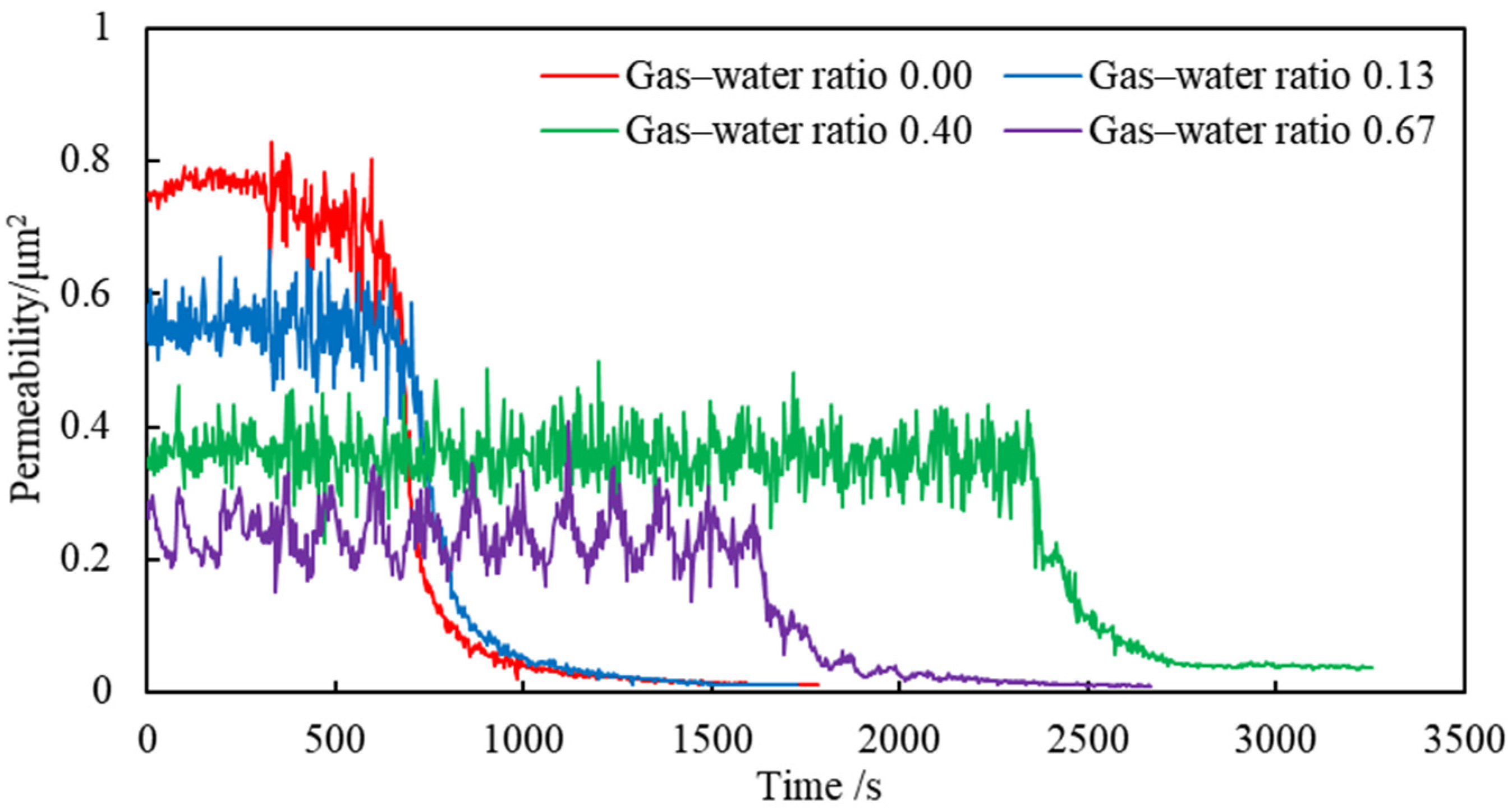
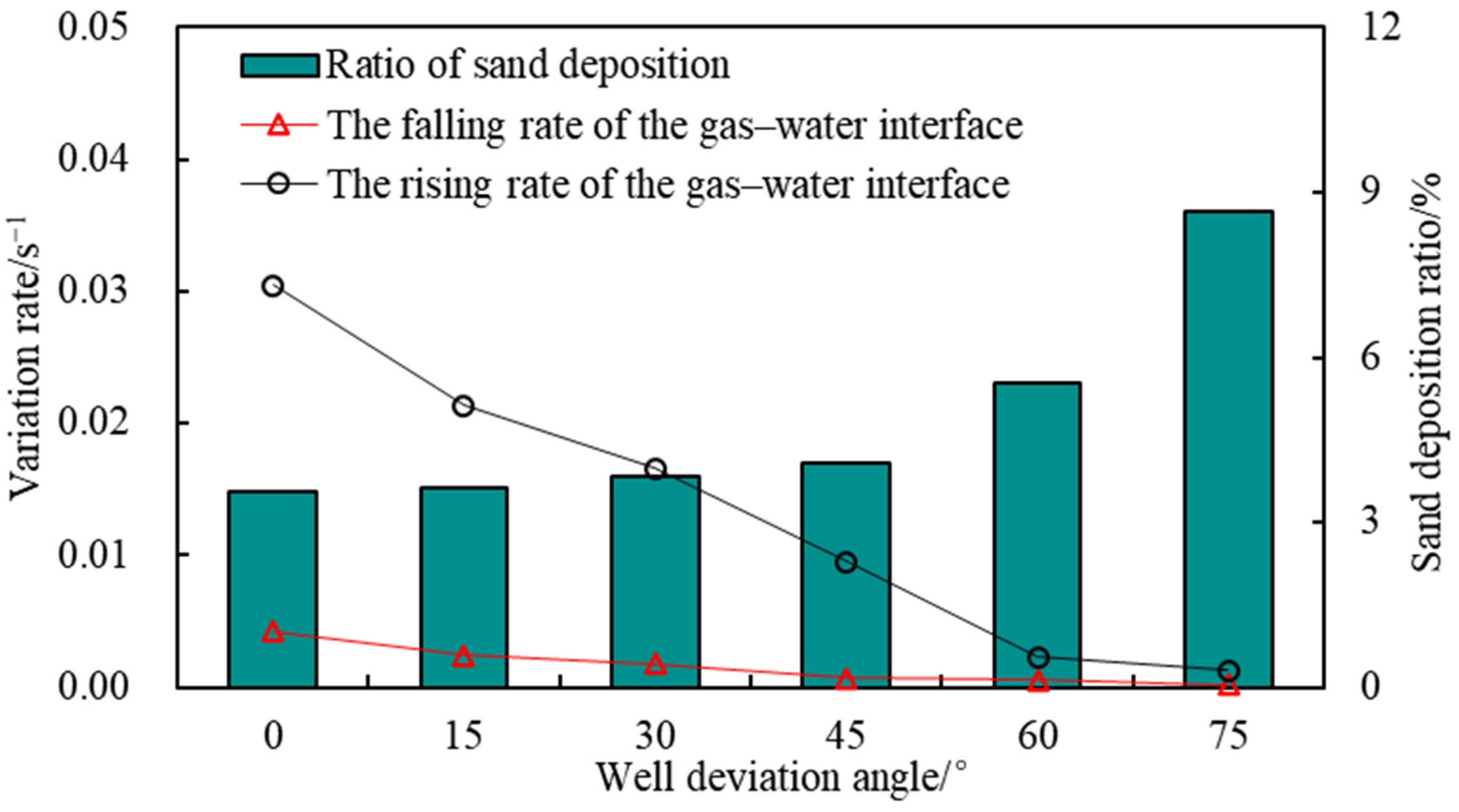


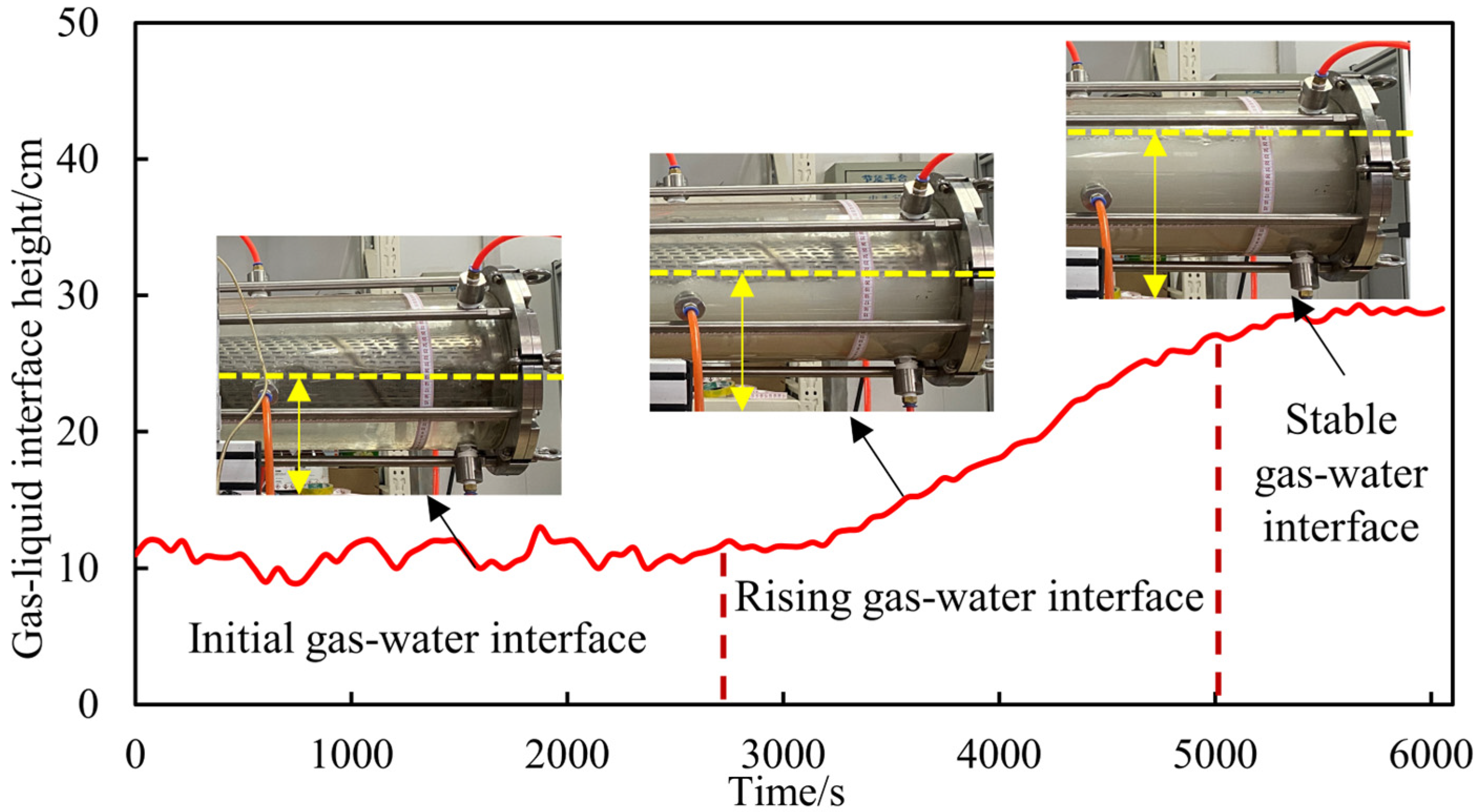
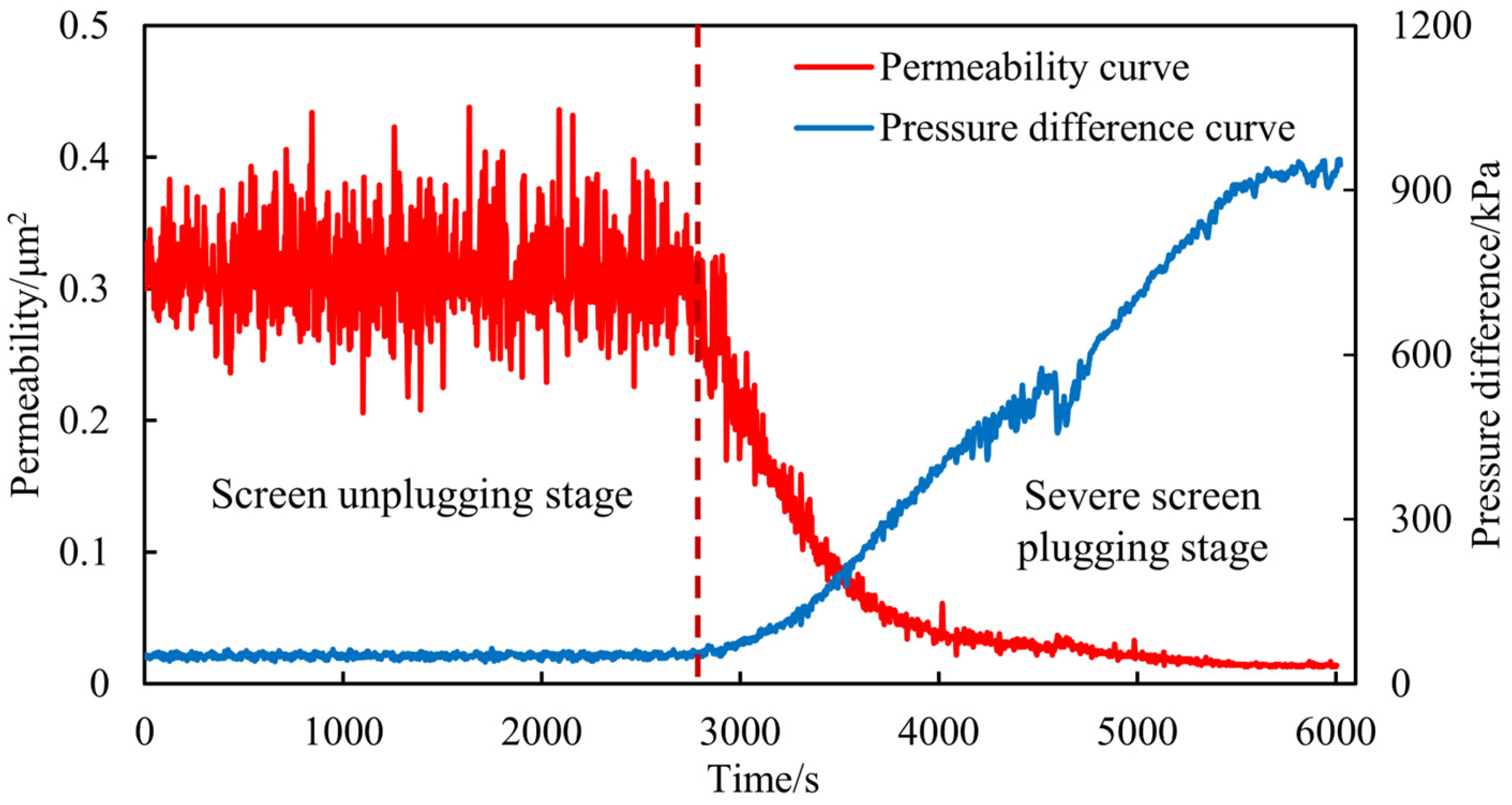
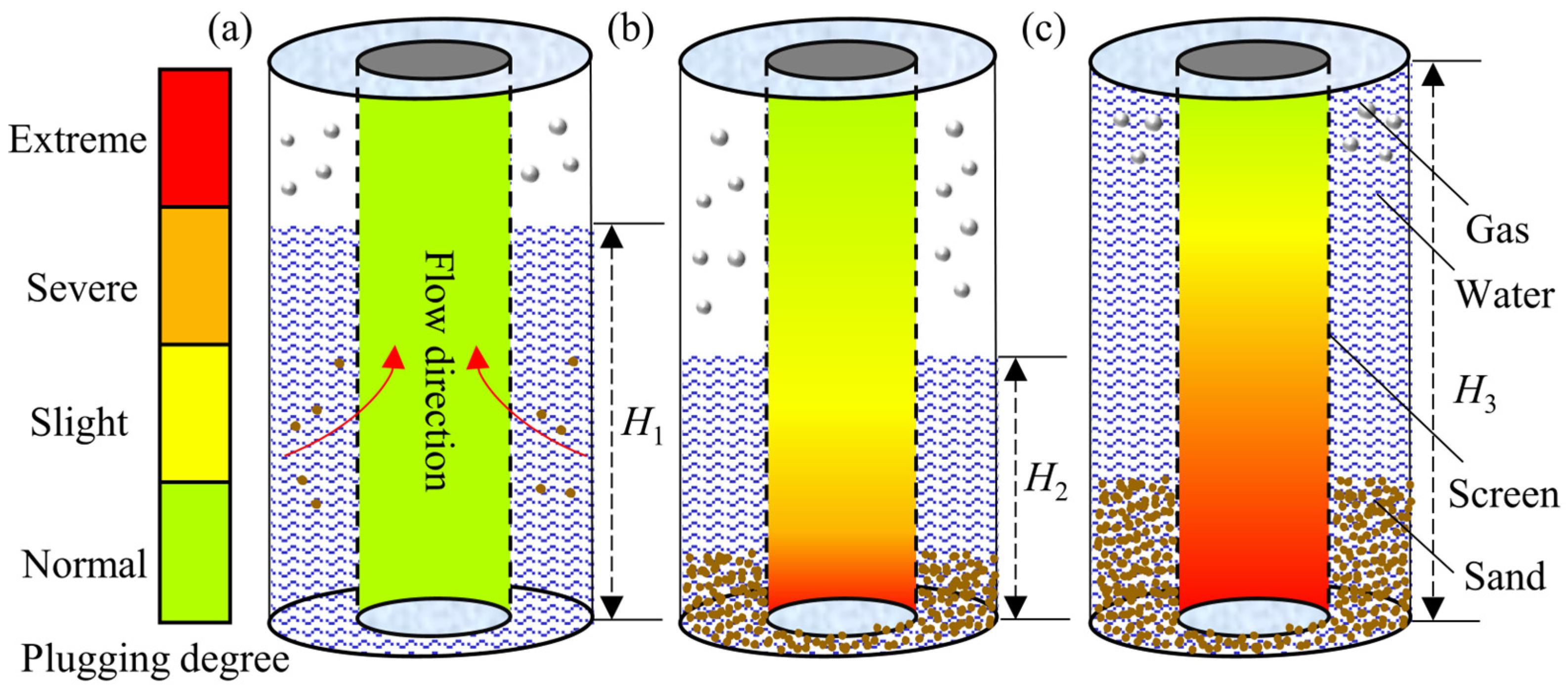

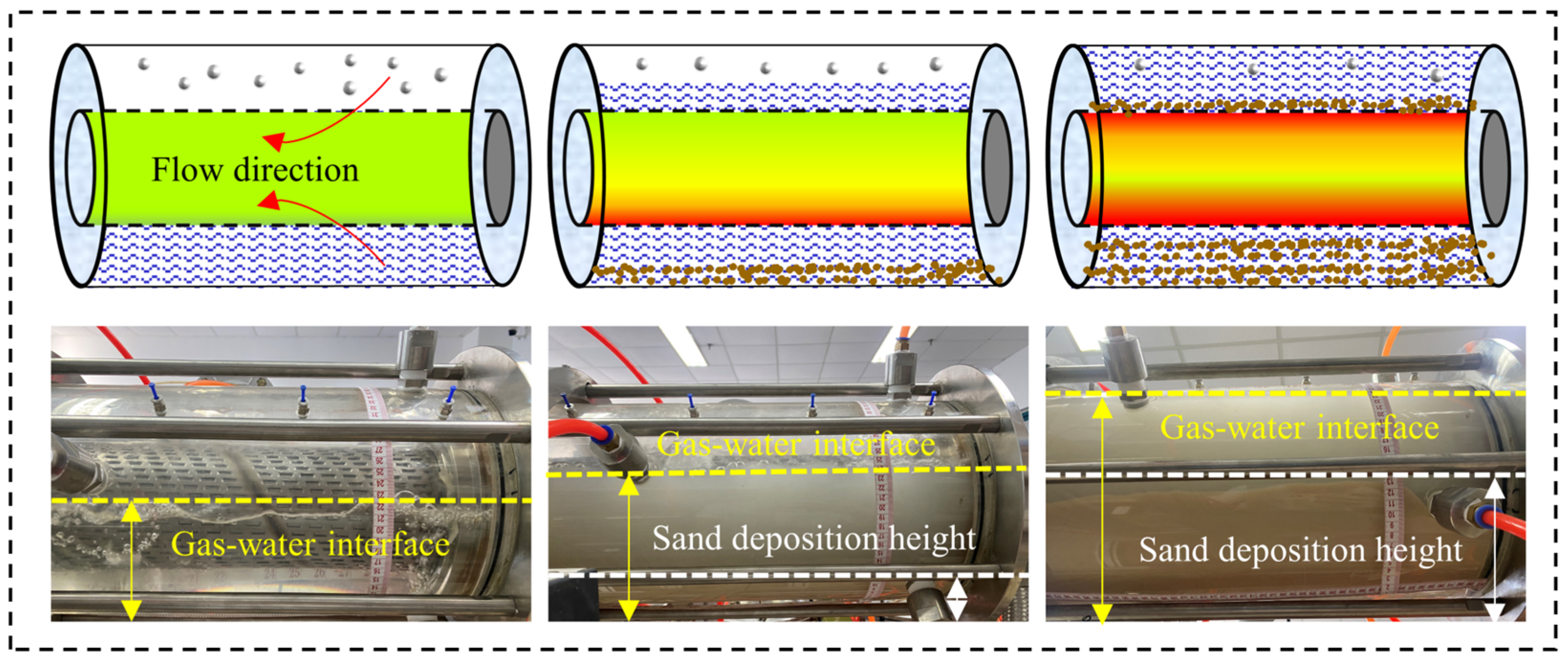
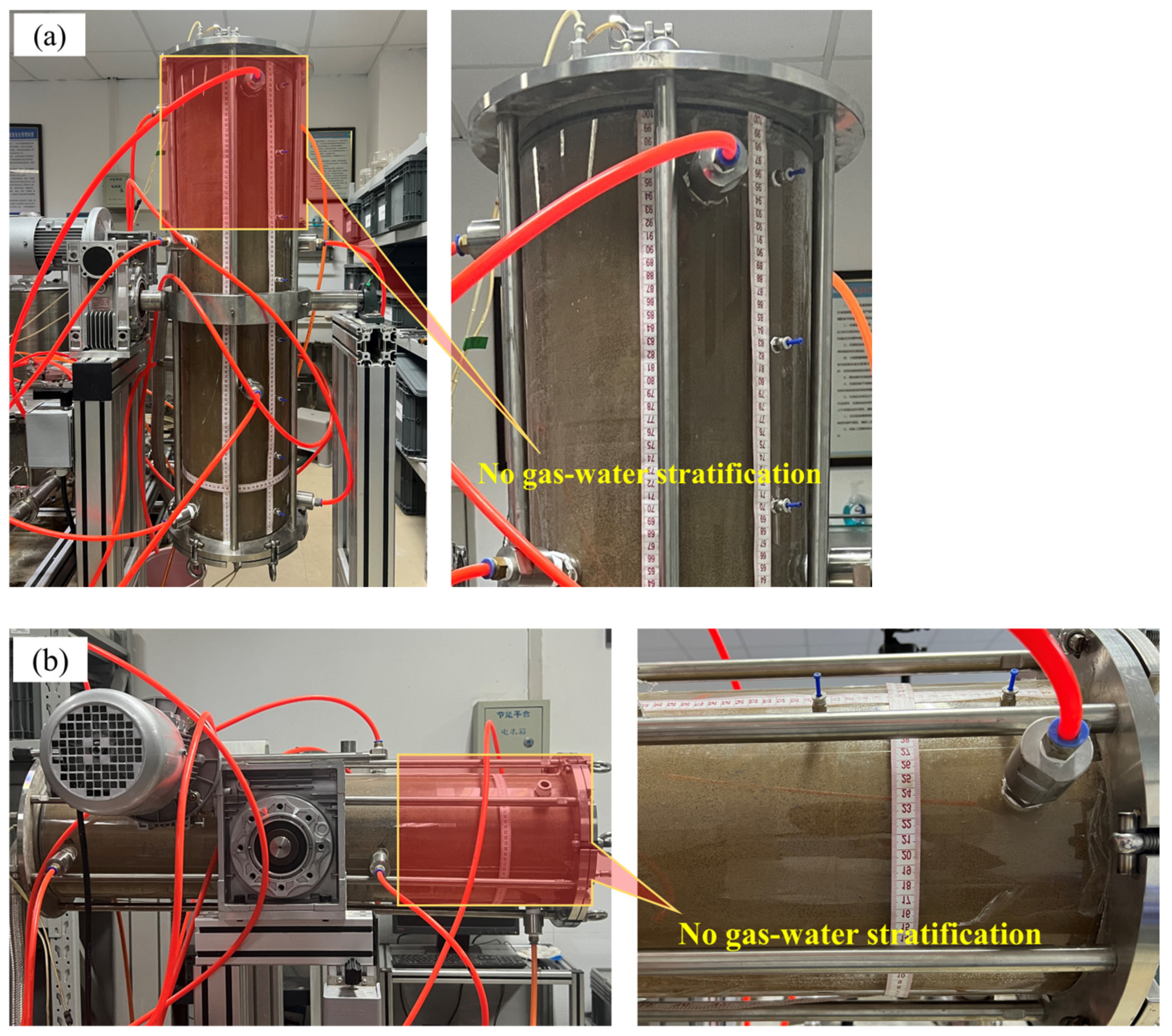

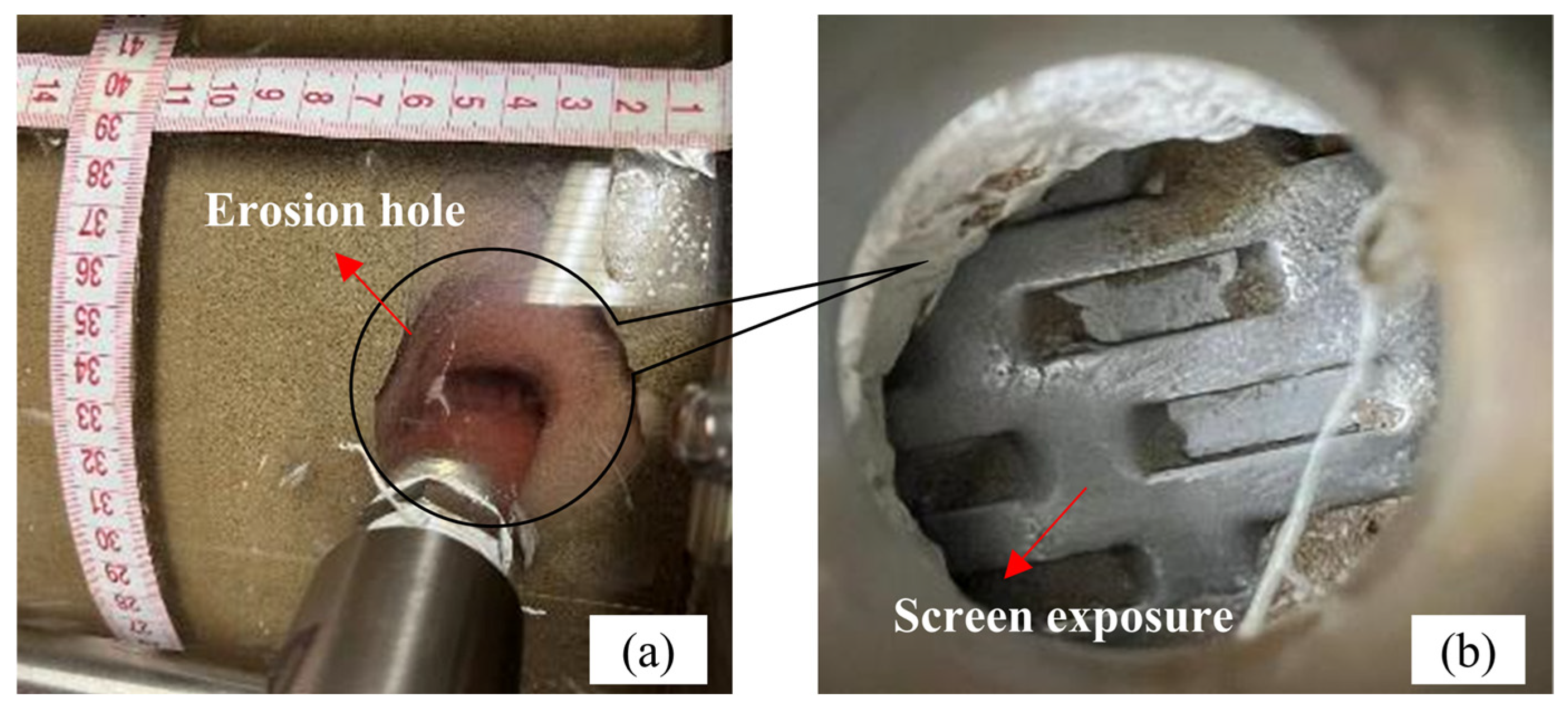

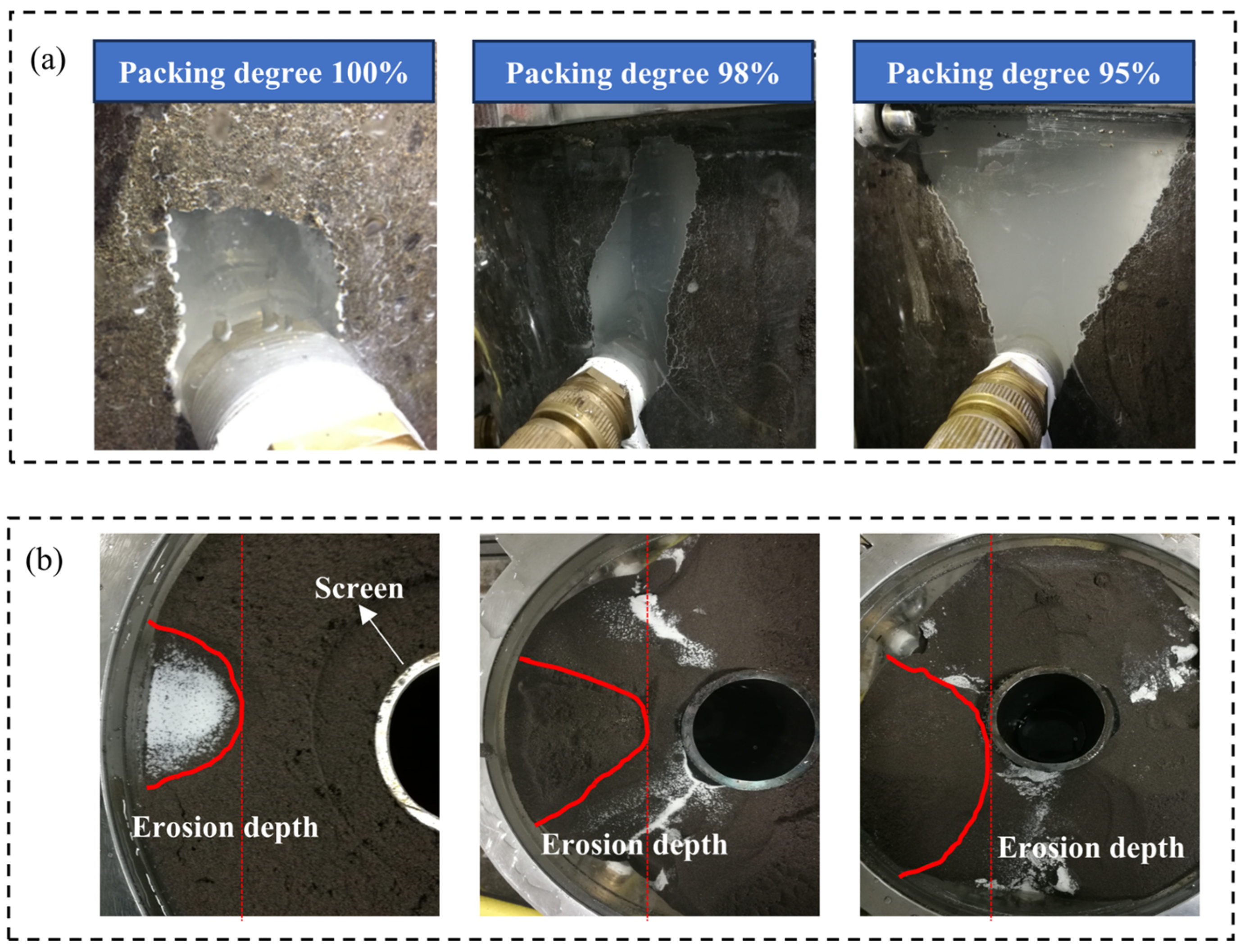


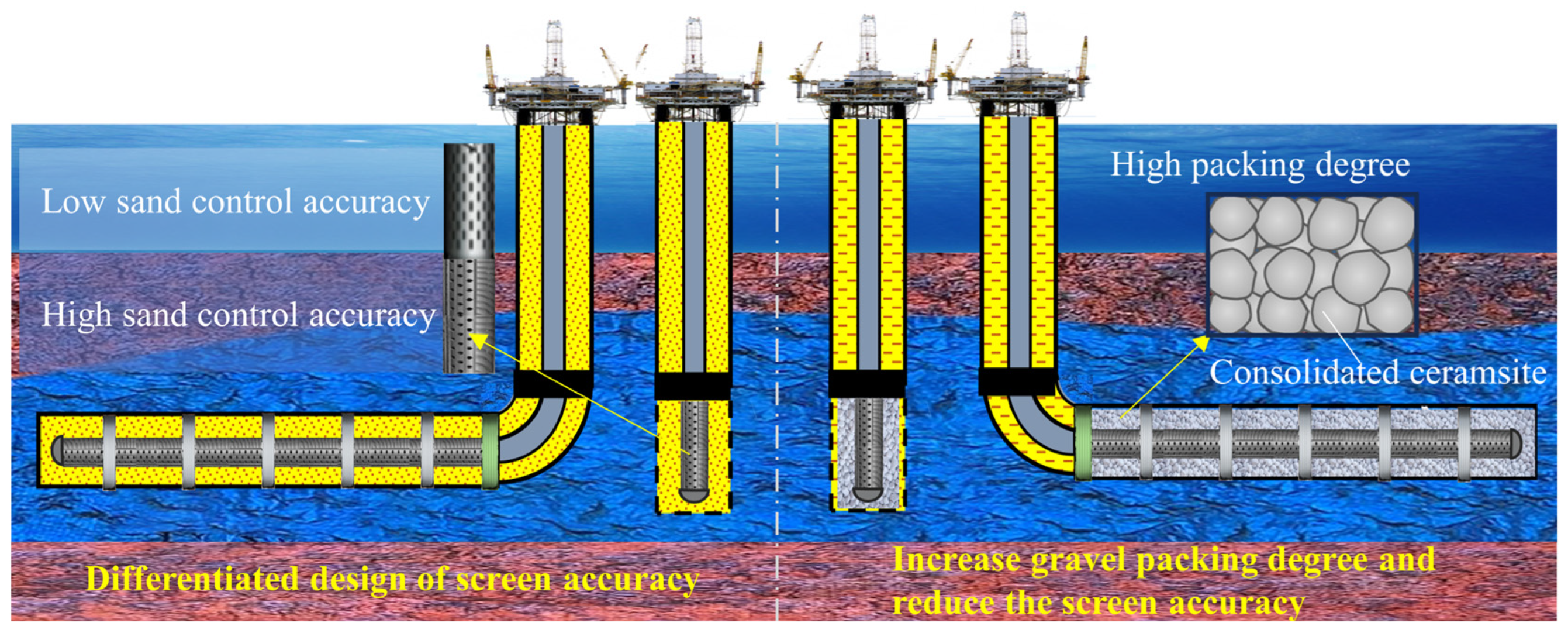
| Number | Sand Control Completion | Deviation Angle/° | GWR/m3/m3 | VCSP/% | Factor |
|---|---|---|---|---|---|
| 1 | SAS | 0 | 0.67 | 0.2 | VCSP |
| 2 | SAS | 0 | 0.67 | 0.3 | |
| 3 | SAS | 0 | 0.67 | 0.4 | |
| 4 | SAS | 0 | 0.67 | 0.5 | |
| 5 | SAS | 0 | 0 | 0.3 | GWR |
| 6 | SAS | 0 | 0.13 | 0.3 | |
| 7 | SAS | 0 | 0.4 | 0.3 | |
| 8 | SAS | 0 | 0.67 | 0.3 | |
| 9 | SAS | 15 | 0.67 | 0.3 | Deviation angle |
| 10 | SAS | 30 | 0.67 | 0.3 | |
| 11 | SAS | 45 | 0.67 | 0.3 | |
| 12 | SAS | 60 | 0.67 | 0.3 | |
| 13 | SAS | 75 | 0.67 | 0.3 | |
| 14 | SAS | 90 | 0.67 | 0.3 | |
| 15 | GP | 0 | 0.67 | 0.3 | GWR |
| 16 | GP | 90 | 0.9 | 0.3 | |
| 17 | GP | 90 | 1.8 | 0.3 | |
| 18 | GP | 90 | 2.7 | 0.3 |
| GWR/(m3/m3) | Initial Permeability/D | Plugging Permeability/D | Permeability with Erosion Hole/D | Recovery Rate/% | Loss Rate/% |
|---|---|---|---|---|---|
| 0.9 | 9.723 | 0.132 | 2.539 | 1823.48 | 98.64 |
| 1.8 | 9.719 | 0.154 | 3.196 | 1975.32 | 98.42 |
| 2.7 | 9.727 | 0.279 | 5.936 | 2027.60 | 97.13 |
Disclaimer/Publisher’s Note: The statements, opinions and data contained in all publications are solely those of the individual author(s) and contributor(s) and not of MDPI and/or the editor(s). MDPI and/or the editor(s) disclaim responsibility for any injury to people or property resulting from any ideas, methods, instructions or products referred to in the content. |
© 2024 by the authors. Licensee MDPI, Basel, Switzerland. This article is an open access article distributed under the terms and conditions of the Creative Commons Attribution (CC BY) license (https://creativecommons.org/licenses/by/4.0/).
Share and Cite
Liu, C.; Dong, C.; Shi, H.; Yu, Y.; Yin, B. Gas–Water–Sand Inflow Patterns and Completion Optimization in Hydrate Wells with Different Sand Control Completions. J. Mar. Sci. Eng. 2024, 12, 2071. https://doi.org/10.3390/jmse12112071
Liu C, Dong C, Shi H, Yu Y, Yin B. Gas–Water–Sand Inflow Patterns and Completion Optimization in Hydrate Wells with Different Sand Control Completions. Journal of Marine Science and Engineering. 2024; 12(11):2071. https://doi.org/10.3390/jmse12112071
Chicago/Turabian StyleLiu, Chenfeng, Changyin Dong, Haoxian Shi, Yanjiang Yu, and Bin Yin. 2024. "Gas–Water–Sand Inflow Patterns and Completion Optimization in Hydrate Wells with Different Sand Control Completions" Journal of Marine Science and Engineering 12, no. 11: 2071. https://doi.org/10.3390/jmse12112071
APA StyleLiu, C., Dong, C., Shi, H., Yu, Y., & Yin, B. (2024). Gas–Water–Sand Inflow Patterns and Completion Optimization in Hydrate Wells with Different Sand Control Completions. Journal of Marine Science and Engineering, 12(11), 2071. https://doi.org/10.3390/jmse12112071






